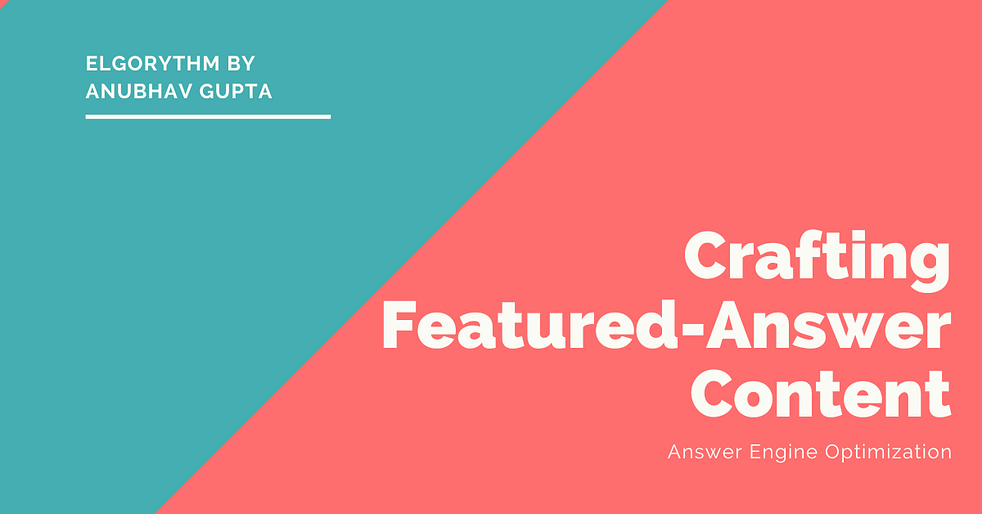Answer Engine Optimization (AEO) means optimizing your content so that search platforms (like Google, Bing, or AI assistants) deliver it as the answer – not just as a link. In other words, AEO focuses on making your content the answer in featured snippets, voice responses, or AI chat results. To measure Answer Engine Optimization performance means tracking how often and how prominently your brand or content appears in those direct answers. This is different from traditional SEO: instead of just measuring page views or organic rankings, you measure answer visibility. For example, key AEO metrics include mentions in answer results, featured snippet count, voice-search answer share, and referral traffic from AI assistants. In this post, we’ll explain AEO performance measurement, list AEO-specific KPIs, recommend tracking tools (like Bing Webmaster Tools and SE Ranking), lay out action steps and a tracking template, point out common pitfalls, and answer your top FAQs on AEO.
What it means to measure answer engine optimization?
Figure: “Answer Engine Optimization (AEO)” – optimizing content to be the direct answer. AEO performance measurement is about tracking your visibility in answer features instead of just clicks. In practice, that means monitoring if and how your content is used by answer engines (AI tools and voice assistants). For example, a leading guide explains that AEO involves “optimizing your content so that search platforms can directly provide answers to user queries” – through featured snippets, voice responses, or AI chat – and measuring AEO means checking how often your content is that answer. In other words, instead of watching only traffic or keyword rank, you watch things like “Is our brand being cited in ChatGPT or Google’s AI answers?” or “How many voice queries return our answer?”.
Practically, you might ask: “How often do people get our answer without clicking away?” and “Which AI tools mention our brand in their answers?” When we say AEO performance, we mean indicators such as brand mentions in AI-generated answers and how often our pages are picked as the answer. For example, CXL notes that AEO metrics include mentions in answer results, featured snippet count, voice search share, and AI-referral traffic. By focusing on these, marketers can measure AEO success.
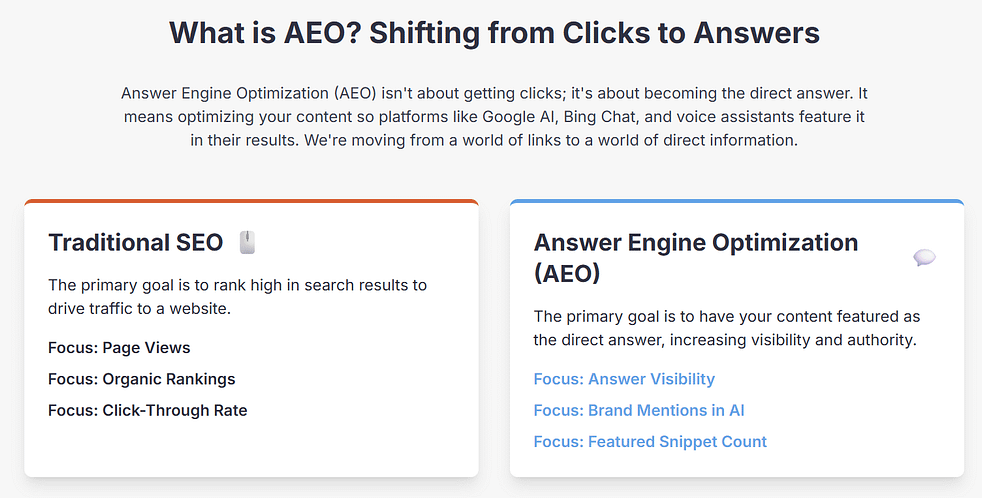
Key AEO Metrics (KPIs) to Track
Measuring AEO means choosing the right KPIs. Unlike SEO’s usual metrics (rankings, clicks, sessions), AEO KPIs center on visibility and influence in answer results. Important AEO KPIs include:
- Answer mentions: How often your brand or content is mentioned in AI answers. This is a core visibility metric. (For example, “Brand X is listed among the top AI-recommended tools” is a win, even if it didn’t bring traffic.)
- Featured snippet and “People Also Ask” count: The number of queries for which your content appears in Google’s featured snippet or PAA boxes. These are prime answer spots; tracking how many snippets you earn shows AEO reach.
- Voice-search answer share: The share of voice or percentage of voice queries (or AI chat queries) that return your content as the answer. For example, if 10% of smart-home assistant answers for “best running shoes” include your brand, that’s a useful KPI.
- AI-referral traffic: The amount of referral traffic from AI platforms (ChatGPT, Bing Chat, etc.). Many AI tools add UTM tags or referrers (e.g. utm_source=chatgpt.com) when users click through. Tracking these in Google Analytics shows how many leads and conversions came from AI answers.
- Engagement on answer-driven visits: Since AEO often involves “zero-click” answers, actual visits may drop. So measure engagement quality on the visits you do get. Key metrics: bounce rate, average session duration, pages/session. If AI is doing research for the user first, the visitors who do click are usually highly qualified – you should see better engagement.
- Conversion and downstream metrics: Finally, track actual conversions (leads, sales) from AI-driven traffic. Many brands see high conversion rates from AI referrals. Key KPIs include form submissions, demo requests, purchases, or any GA4 goals tagged to AI referrals. (For example, credit an e-commerce sale that came from a ChatGPT source.)
In practice, a marketing team might set up a dashboard with these KPIs, comparing traditional SEO metrics (impressions, CTR) to these AEO-specific metrics. The focus should be on “visibility” metrics (appearances in answers) as the primary measure of AEO success.
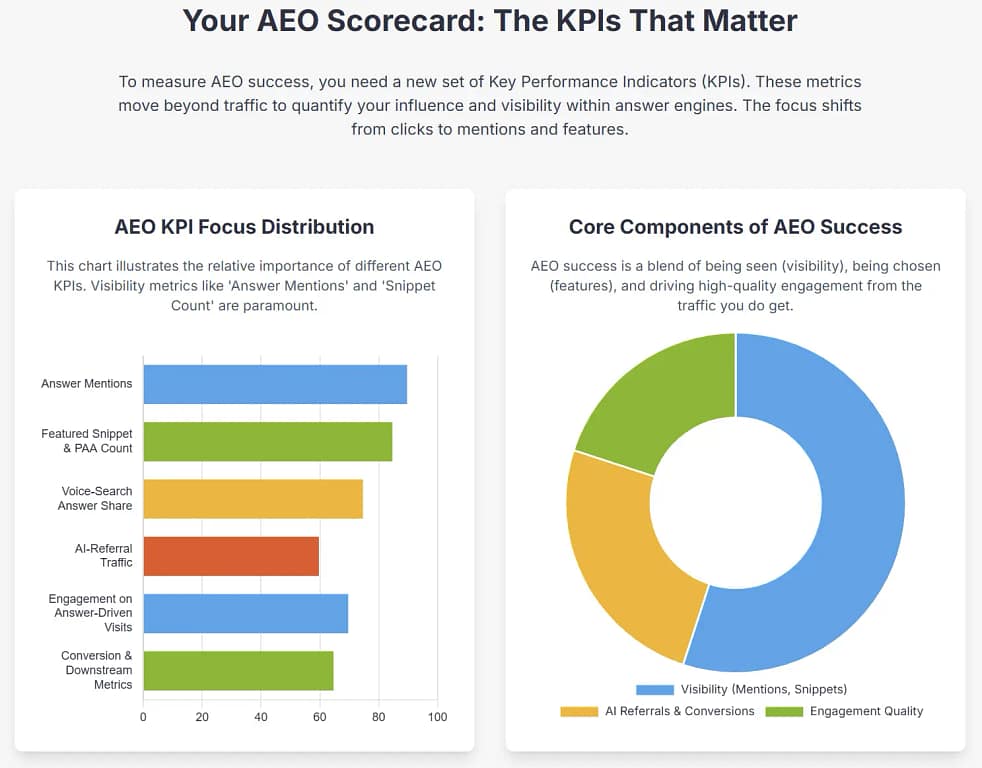
Tools to Measure Answer Engine Optimization Performance
There aren’t many free “AEO analytics” dashboards yet, but several tools can help:
- Bing Webmaster Tools (Performance Report): Bing’s new Performance report combines web and chat (AI) data. It now shows clicks, impressions, and CTR for Bing search + Bing Chat combined. This means you can see if your site is being triggered by AI queries on Bing. By checking the Search Keywords or Impressions report in Bing Webmaster Tools, you can identify conversational queries (longer, question-like queries) where your site appears. This helps indirectly measure voice/search answer impact. (Plus, BWT still gives traditional keyword clicks/positions – handy baseline.)
- SE Ranking (AEO Tool): SE Ranking offers a dedicated AEO tracking tool. It crawls AI answer engines (like ChatGPT and Google’s AI Overviews) and reports how often your brand or content is mentioned or linked in those answers. It shows your “answer visibility score,” how you rank in AI answers versus competitors, and tracks changes over time. Using SE Ranking’s AEO tool, you can automate tracking of your answer appearances and brand mentions across multiple AI platforms.
- Google Analytics 4 (GA4) and UTM tracking: Set up conversion tracking for AI-sourced traffic. For example, ChatGPT append UTM tags (e.g. utm_source=chatgpt.com), so GA4 can report ChatGPT-referred sessions. Monitor these as separate traffic sources to see conversions or behavior from AI clicks. (Similarly, Perplexity includes a referer header.) This isn’t a direct AEO tool, but it helps measure business impact (ROI) from AI answers.
- Search Console / Google Analytics (indirect): Google Search Console doesn’t label answers, but you can filter GSC by question-like queries to see impressions/CTR on long-tail queries. Google Analytics (like GA4) will also include AI visits under “direct” if UTM tags aren’t present, but you can often infer voice/AI traffic by spikes in “direct” traffic to content without changes in other channels. Still, GSC and GA4 are more SEO/traffic tools; they can complement your AEO data.
(Note: There are also emerging platforms like Goodie AI or Profound that specialize in AEO tracking with large-scale AI querying, but these may be overkill for many businesses.)
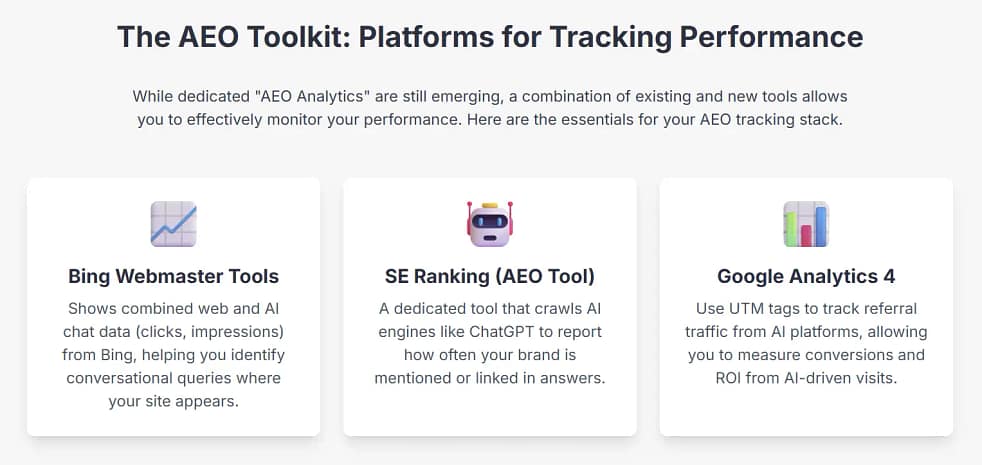
Actionable Steps & Tracking Framework
To systematically measure AEO performance, follow these steps:
- Benchmark current visibility. List the key questions or topics your business answers. For each, manually check if your brand/content appears in AI answers (ChatGPT, Google AI Overview, Bing Chat, Perplexity, etc.). Record a baseline share of voice: e.g. “Our brand appears in answers for 2 of 10 target queries.” As Amsive advises, document your current AI visibility (brand mentions and position in answers) so you have a starting point.
- Set up tool monitoring. Use Bing Webmaster Tools to get baseline impressions/clicks on these queries. Enable SE Ranking’s AEO tool (or similar) and configure it to track your main topics. In SE Ranking, enter your target queries and let it measure how often ChatGPT or Google AI cites your site. In GA4, create a custom report or dashboard for any traffic tagged from ChatGPT or other AI sources.
- Create a tracking sheet or dashboard. Build a simple spreadsheet or dashboard to log your metrics over time. Key columns might be: Query/Topic, AI Platform (ChatGPT, Bing AI, etc.), Brand Mention Count, Featured Snippet Count, Answer Position, Voice Search Rank, AI Referral Conversions, Date/Benchmark. For example, you might note that on May 1, your blog appeared in 3 Google AI answers (and ranked #1 twice), and had 5 ChatGPT mentions. Tracking this each month helps spot trends. You can even include notes about any changes (e.g. “added FAQ schema on May 15 – saw +2 snippet appearances by June”).
- Review and analyze regularly. Each month (or quarter), update the sheet with new data from your tools. Check if brand mentions have risen, if you’ve earned more snippets, or if AI referrals increased. As Amsive recommends, track “mention frequency, citation context, and response positioning” across queries. Use charts or conditional formatting to spot wins (green) and issues (red).
- Iterate and refine. Use insights to improve content. If certain pages aren’t being cited, tweak them: add clear question-and-answer sections, use schema markup, or front-load answers (tips from AEO best practices). Then see if the changes boost your mention metrics. Also monitor competitors: tools like SE Ranking AEO or manual checks can show if rivals are stealing share of voice, guiding your strategy.
- Align with business goals. Besides pure visibility, connect AEO metrics to outcomes. For example, if ChatGPT referrals spike, check if lead forms or sales from those sessions increased. As Bing’s blog notes, with Bing Chat in Performance, you can tie “web + chat” clicks back to your business KPIs. In GA4, compare conversion rates for AI-sourced traffic vs organic SEO traffic.
By formalizing AEO tracking in this way, you create a framework: benchmark → measure → optimize → repeat. This ensures you’re not just guessing about AI impact, but actually quantifying your answer-engine visibility and its business effect.
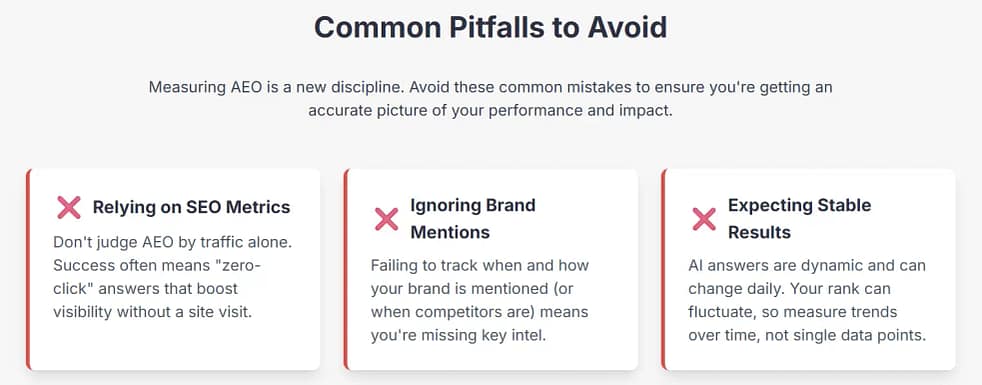
Common Pitfalls to Avoid during AEO
When measuring AEO, watch out for these mistakes:
- Relying only on traditional SEO metrics. AEO is visibility, not just traffic. Don’t focus only on pageviews or Google rank. As experts warn, “Relying only on traditional SEO metrics instead of AI-specific indicators” is a big mistake. If you only monitor clicks, you’ll miss the fact that AI is answering users without sending them to you.
- Ignoring brand mentions and sentiment. Don’t skip tracking who is being mentioned in answers. If AI answers always mention a competitor first, that’s a signal to investigate. Amsive cautions: avoid “not tracking brand mentions, sentiment, and share of voice across AI engines”. Set up brand-monitoring queries (e.g. “best [your product] alternatives”) and see if you appear.
- Assuming one strategy fits all AI platforms. Each AI system may use different sources (e.g. ChatGPT vs. Google AI). Don’t assume changes that improved your Google snippets will automatically improve Bing Chat results. In other words, “assuming one optimization strategy works across all AI platforms” is a pitfall. You may need platform-specific tweaks.
- Expecting stable, immediate results. AI answers are powered by evolving data (Retrieval-Augmented Generation). If your content wasn’t cited today, it might be tomorrow – and vice versa. Don’t expect a fixed ranking. As NoGood’s analysis notes, LLMs reference live web data that can change anytime. This means your AEO metrics can fluctuate; patience is key.
- Overlooking manual audits. Automated tools are great, but periodic manual spot-checks are essential. For example, every few weeks ask ChatGPT or Gemini a key question and see if your site is mentioned. This can catch issues (like if an AI model started citing a new source).
- Forgetting analytics setup. If you don’t tag AI referrals in Google Analytics, all ChatGPT clicks might show up as “direct” traffic, hiding their source. Be sure to filter or tag AI-driven visits so you can measure conversions properly.
By avoiding these pitfalls and focusing on AEO-specific data, you’ll get a clearer picture of how AI and voice search are impacting your brand.
Frequently Asked Questions
What is Answer Engine Optimization (AEO)?
Answer Engine Optimization (AEO) is the practice of optimizing content so that AI-powered tools and answer engines (like Google’s AI Overviews, Bing Chat, or ChatGPT) can cite it directly in response to user questions. In other words, AEO makes your content the answer in AI/voice search. The goal is to boost your brand’s visibility in AI-generated answers instead of just improving traditional search rankings.
How do I measure AEO performance?
Measure AEO performance by tracking AI visibility metrics, not just web traffic. For example, monitor how often your content appears in featured snippets or voice answers, and count AI referrals. Good practices include:
- Featured snippet appearances: How many snippets or “People Also Ask” boxes feature your content.
- Voice/AI answer ranking: Your position in voice assistant results or AI chat lists (are you the first answer mentioned?).
- AI referrals: Leads or visits from AI sources (like ChatGPT clicks with utm_source).
- Engagement metrics: Bounce rate, time on page, pages per session for AI-driven traffic (to ensure quality).
Use tools (Bing Webmaster Tools, SE Ranking, GA4) to gather these numbers. For example, one guide recommends using snippet tracking and voice rank tracking tools, plus analytics for session data.
What key metrics (KPIs) should I track for AEO?
Key AEO KPIs include:
- Mentions in AI answers: Frequency your brand appears in AI responses (visibility).
- Featured snippet count: Number of keywords where you hold the snippet or answer box.
- Voice search/AI share of voice: Percent of targeted voice/AI queries that mention your content.
- AI referral traffic: Visits or conversions from ChatGPT, Bing Chat, etc. (often tracked via UTMs).
- Engagement/conversion on AI visits: Bounce rate, pages/session, time on site, and conversion rate for traffic coming from AI sources.
These metrics focus on answer visibility and quality of AI-driven traffic, rather than just raw clicks.
Which tools can help me track AEO performance?
Useful tools include:
- Bing Webmaster Tools: Its Performance Report now combines web+chat data, giving clicks and impressions from Bing’s AI chat and search. Use it to find conversational query impressions.
- SE Ranking (AEO Tool): Monitors how often and where your brand is mentioned or linked in AI answer responses (ChatGPT, Google AI). Great for automated visibility tracking.
- Google Analytics 4: Set up filters or custom reports for AI traffic (look for utm_source=chatgpt.com or Perplexity referrals) to see conversions and engagement from AI referrals.
- (Bonus) Search Console: While not AI-specific, you can filter search queries for question-like terms to infer voice/AI interest.
- (Advanced) AEO Platforms: Tools like Goodie AI or Profound specialize in AEO analytics (large-scale AI query tracking), if you need enterprise-level insights.
What mistakes should I avoid when measuring AEO?
Avoid these AEO measurement mistakes:
- Relying only on SEO metrics: Don’t judge AEO by organic traffic alone. AEO success often means “no-click” answers that won’t show as visits.
- Neglecting brand mention tracking: Always monitor how often AI answers mention your brand or content. Failing to track “mentions and share of voice” is a common oversight.
- Expecting consistency: AI answers can change with updates. Don’t assume your answer will always rank first; measure frequently.
- One-size-fits-all strategy: Bing’s AI and ChatGPT use different sources. Don’t assume improving Google answers automatically fixes Bing answers.
- Forgetting conversions: If you don’t tag AI referrals, you’ll miss conversions. Be sure to track ChatGPT/Gemini clicks in GA4 (with UTM tags).
By focusing on AI-specific visibility and avoiding these pitfalls, you’ll get an accurate picture of your AEO performance.



